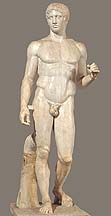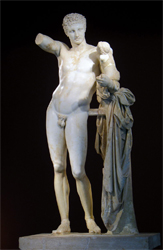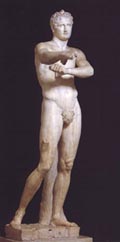
|

|
| Praxiteles (act. c. 370-330 B.C.), Hermes
with the Infant Dionysos, Olympia, c. 340-330 B.C. 360 degree view of the Hermes. |
Polykleitos, Doryphoros, c. 450-440 B.C. |
|
  
|
| Head of the Doryphoros |
Details of the Hermes with Dionysos |

|

|
| Head of a Girl, from Chios, 3rd c. B.C.
(in the manner of Praxiteles). |
Praxiteles, Aphrodite of Knidos, Roman
copy of an original of c. 350 B.C. 360 degree view of the Aphrodite of Knidos. |

|

|
| In the manner of Skopas (c. 370-330 B.C.)
Battle of Amazons and Greeks, detail of the frieze from the Mausoleum
of Halikarnassos. mid 4th B.C. |
Orgiastic Maenad (Roman copy), in the manner
of Skopas, c. 340 B.C. |

|

|
| Lysippos (act. 360-300 B.C.), Apoxyomenos
(Scraper), c. 330 B.C. (Roman copy). For 360 degree view of Apoxyomenos |
Polykleitos, Doryphoros, c. 450-440 B.C. 360 degree view of the Doryphoros. |
| |

|
| |
Praxiteles, Hermes with the Infant Dionysos/ |
| |

|
|
| |
Other views of the Apoxyomenos. |
| |

|
| |
In the manner of Lysippos, Head of Alexander
the Great. |








